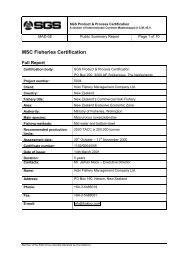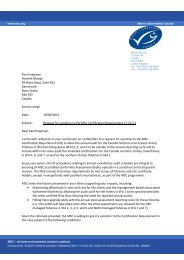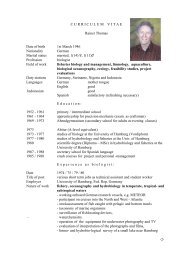SGS Product & Process Certification - Marine Stewardship Council
SGS Product & Process Certification - Marine Stewardship Council
SGS Product & Process Certification - Marine Stewardship Council
Create successful ePaper yourself
Turn your PDF publications into a flip-book with our unique Google optimized e-Paper software.
General Comments on the Assessment Report (optional)<br />
1. In the North Sea two species of the genus Pollachius occur: Pollachius virens or saithe and Pollachius pollachius or pollack. In the<br />
southern North Sea only adult specimens of pollack occur. The species shown in Figure 4 is a clear example of a pollack. Saithe in the<br />
North Sea has a much more northerly distribution. All references throughout the report to saithe should be changed in pollack. Agreed, text<br />
etc amended as required.<br />
Also there is no quota for pollack in the North Sea (ICES area IV) and the text below figure 4 on TAC and management should therefore be<br />
deleted. Done<br />
2. Our knowledge of sea bass, life history, stocks, and also fishery, is largely based on what is known for English waters. About the<br />
situation in the Netherlands not a lot is known, but what is known has been used in the report.<br />
3. A number of times the remark is made that there are no discards in this fishery. But at the same time it is said that small cod, below the<br />
legal minimum size, are thrown back into the sea (paragraph 4.1 on page 28). So there are discards, and survival of these discards is<br />
probably quite high, and no threat to the recovery of the North Sea cod stock. Remarks that there are no discards should be rephrased. The<br />
text has been amended to clarify that the only discards are of species that are retained and landed, and that there is no non-retained by<br />
catch (a difficulty with the MSC definitions).<br />
4. Page 48, line 5 under Table 8: it is not clear to me where the score of 2.7 comers from.<br />
In the footer of the same page it is said that weightings are given in Table 10 above: there is no table 10. The text above Table 8 explains<br />
how the selectivity values for each of the hook and line, gill net and trawl fisheries were scored, but the aggregate score (2.7) was obtained<br />
by weighting these scores (2,2,3) by the proportional landings taken by the 3 metiers in the North Sea (Table 10 is immediately below). The<br />
foot note has now been incorporated in the text for clarification.<br />
5. Under Recommendation 1 (page 56) it is said that the Client should encourage IMARES to extend the collection of biological information<br />
on sea bass landed in the Netherlands. As long as this is not a ―legal task‖, or as long as this data-collection is not specifically paid for it is<br />
highly unlikely that this will be done by IMARES. Point noted<br />
6. In the scoring comments for 2.3.1 (page 84) spurdog (Squalus acanthias) is being mentioned as incidentally being caught. It does not<br />
seem very likely to catch spurdog in this area. More likely the ―shark‖ that is being caught are smooth hound (Mustelus sp.). We have to<br />
take information from the client who, incidentally, fish widely across the southern North Sea where spurdog do occur.<br />
Page 113 of 151





